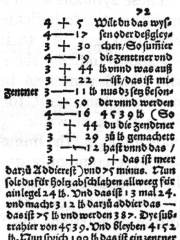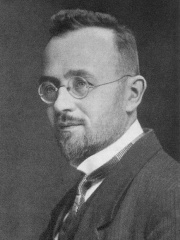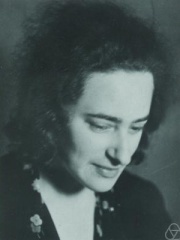





The Most Famous
MATHEMATICIANS from Czechia
This page contains a list of the greatest Czech Mathematicians. The pantheon dataset contains 1,004 Mathematicians, 7 of which were born in Czechia. This makes Czechia the birth place of the 25th most number of Mathematicians behind Canada, and Denmark.
Top 7
The following people are considered by Pantheon to be the most legendary Czech Mathematicians of all time. This list of famous Czech Mathematicians is sorted by HPI (Historical Popularity Index), a metric that aggregates information on a biography's online popularity.

1. Kurt Gödel (1906 - 1978)
With an HPI of 79.53, Kurt Gödel is the most famous Czech Mathematician. His biography has been translated into 95 different languages on wikipedia.
Kurt Friedrich Gödel ( GUR-dəl; German: [ˈkʊʁt ˈɡøːdl̩] ; April 28, 1906 – January 14, 1978) was a logician, mathematician, and philosopher. Considered along with Aristotle and Gottlob Frege to be one of the most significant logicians in history, Gödel profoundly influenced scientific and philosophical thinking in the 20th century (at a time when Bertrand Russell, Alfred North Whitehead, and David Hilbert were using logic and set theory to investigate the foundations of mathematics), building on earlier work by Frege, Richard Dedekind, and Georg Cantor. Gödel's discoveries in the foundations of mathematics led to the proof of his completeness theorem in 1929 as part of his dissertation to earn a doctorate at the University of Vienna, and the publication of Gödel's incompleteness theorems two years later, in 1931. The incompleteness theorems address limitations of formal axiomatic systems. In particular, they imply that a formal axiomatic system satisfying certain technical conditions cannot decide the truth value of all statements about the natural numbers, and cannot prove that it is itself consistent. To prove this, Gödel developed a technique now known as Gödel numbering, which codes formal expressions as natural numbers. Gödel also showed that neither the axiom of choice nor the continuum hypothesis can be disproved from the accepted Zermelo–Fraenkel set theory, assuming that its axioms are consistent. The former result opened the door for mathematicians to assume the axiom of choice in their proofs. He also made important contributions to proof theory by clarifying the connections between classical logic, intuitionistic logic, and modal logic. Born into a wealthy German-speaking family in Brno, Gödel emigrated to the United States in 1939 to escape the rise of Nazi Germany. Later in life, he suffered from mental illness, which ultimately claimed his life: believing that his food was being poisoned, he refused to eat and starved to death.

2. Leo Perutz (1882 - 1957)
With an HPI of 65.96, Leo Perutz is the 2nd most famous Czech Mathematician. His biography has been translated into 28 different languages.
Leopold Perutz (2 November 1882 – 25 August 1957) was an Austrian novelist and mathematician. Born in Prague, he lived in Vienna until the Nazi Anschluss in 1938, when he emigrated to Palestine. According to the biographical note on the Arcade Publishing editions of the English translations of his novels, Leo was a mathematician who formulated an algebraic equation which is named after him; he worked as a statistician for an insurance company. He was related to the biologist Max Perutz. During the 1950s he returned occasionally to Austria, spending the summer and autumn months in the market town of St. Wolfgang im Salzkammergut in the Salzkammergut resort region and in Vienna. He died in the Austrian spa town of Bad Ischl in 1957. He wrote his first novel, The Third Bullet, in 1915 while recovering from a wound sustained in the First World War. In all Perutz wrote eleven novels, which gained the admiration of Jorge Luis Borges, Italo Calvino, Ian Fleming, Karl Edward Wagner and Graham Greene. Wagner cited Perutz's novel The Master of the Day of Judgment as one of the thirteen best non-supernatural horror novels.

3. Johannes Widmann (1460 - 1505)
With an HPI of 63.44, Johannes Widmann is the 3rd most famous Czech Mathematician. His biography has been translated into 20 different languages.
Johannes Widmann (c. 1460 – after 1498) was a German mathematician. The + and - symbols first appeared in print in his book Mercantile Arithmetic or Behende und hüpsche Rechenung auff allen Kauffmanschafft published in Leipzig in 1489 in reference to surpluses and deficits in business problems. Born in Eger, Bohemia, Widmann attended the University of Leipzig in the 1480s. In 1482 he earned his "Baccalaureus" (Bachelor of Art degree) and in 1485 his "Magister" (doctorate). Widman published Behende und hübsche Rechenung auff allen Kauffmanschafft (German; i.e. Nimble and neat calculation in all trades), his work making use of the signs, in Leipzig in 1489. Further editions were published in Pforzheim, Hagenau, and Augsburg. Handwritten entries in a surviving collection show that after earning his "Magister" Widman announced holding lectures on e.g. calculating on the lines of a calculating board and on algebra. There is evidence that the lecture on algebra actually took place, making it the first known university lecture on this topic. Around 1495 Widmann published the Latin writings Algorithmus integrorum cum probis annexis, Algorithmus linealis, Algorithmus minutiarum phisicarum, Algorithmus minutiarum vulgarium, Regula falsi apud philosophantes augmenti et decrementi appellata und Tractatus proportionum plusquam aureus. He died in Leipzig. When Adam Ries was in Erfurt between 1518 and 1522 he got to know Widmann's algebra lecture script (today in the Saxon State Library) wherefrom he took examples for his own writings.

4. Johann Radon (1887 - 1956)
With an HPI of 59.07, Johann Radon is the 4th most famous Czech Mathematician. His biography has been translated into 20 different languages.
Johann Karl August Radon ([ˈʁaːdɔn]; 16 December 1887 – 25 May 1956) was an Austrian mathematician. His doctoral dissertation was on the calculus of variations (in 1910, at the University of Vienna).

5. Eduard Čech (1893 - 1960)
With an HPI of 58.56, Eduard Čech is the 5th most famous Czech Mathematician. His biography has been translated into 24 different languages.
Eduard Čech (Czech: [ˈɛduart ˈtʃɛx]; 29 June 1893 – 15 March 1960) was a Czech mathematician. His research interests included projective differential geometry and topology. He is especially known for the technique known as Stone–Čech compactification (in topology) and the notion of Čech cohomology. He was the first to publish a proof of Tychonoff's theorem in 1937.

6. Olga Taussky-Todd (1906 - 1995)
With an HPI of 57.96, Olga Taussky-Todd is the 6th most famous Czech Mathematician. Her biography has been translated into 30 different languages.
Olga Taussky-Todd (August 30, 1906 – October 7, 1995) was an Austrian and American mathematician. She published more than 300 research papers on algebraic number theory, integral matrices, and matrices in algebra and analysis.

7. Jessica Fridrich (b. 1964)
With an HPI of 47.61, Jessica Fridrich is the 7th most famous Czech Mathematician. Her biography has been translated into 14 different languages.
Jessica Fridrich is a professor at Binghamton University, who specializes in data hiding applications in digital imagery. She is also known for documenting and popularizing the CFOP method (also known as the "Fridrich method"), one of the most commonly used methods for speedsolving the Rubik's Cube, also known as speedcubing. She is considered one of the pioneers of speedcubing, along with Lars Petrus. Nearly all of the fastest speedcubers have based their methods on Fridrich's, usually referred to as CFOP, that is, Cross, First 2 Layers, Orientation of the Last Layer and Permutation of the Last Layer. The method describes solving the cube in a layer-by-layer fashion. First a "cross" is made on the first layer, consisting of the center piece and four edges (Cross). Next, the first layer's corners and edges of the second layer are put into their correct positions simultaneously in pairs (F2L). The last layer is solved by first orienting the yellow pieces (OLL) and then permuting the last layer of the cube using a few sets of algorithms (PLL).
People
Pantheon has 7 people classified as Czech mathematicians born between 1460 and 1964. Of these 7, 1 (14.29%) of them are still alive today. The most famous living Czech mathematicians include Jessica Fridrich. The most famous deceased Czech mathematicians include Kurt Gödel, Leo Perutz, and Johannes Widmann. As of April 2024, 1 new Czech mathematicians have been added to Pantheon including Jessica Fridrich.
Living Czech Mathematicians
Go to all RankingsDeceased Czech Mathematicians
Go to all RankingsKurt Gödel
1906 - 1978
HPI: 79.53
Leo Perutz
1882 - 1957
HPI: 65.96
Johannes Widmann
1460 - 1505
HPI: 63.44
Johann Radon
1887 - 1956
HPI: 59.07
Eduard Čech
1893 - 1960
HPI: 58.56
Olga Taussky-Todd
1906 - 1995
HPI: 57.96
Newly Added Czech Mathematicians (2025)
Go to all RankingsOverlapping Lives
Which Mathematicians were alive at the same time? This visualization shows the lifespans of the 5 most globally memorable Mathematicians since 1700.

